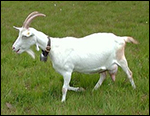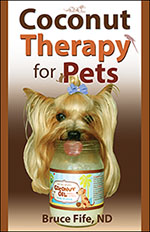|
E-Mail Edition Volume 12 Number 1 |
|||
|
Published Winter, 2015 Published by Piccadilly Books, Ltd., www.piccadillybooks.com. Bruce Fife, N.D., Publisher, www.coconutresearchcenter.org |
|
||
|
If you would like to subscribe to the Healthy Ways Newsletter |
Contents
|
||
|
Coconut Oil for Your Pets
All of the incredible health benefits of coconut that you enjoy can be shared with your pets. Coconut oil is completely safe for all types of animals including your pets and farm animals. Here are a couple of testimonials, the first concerning a dog and the second a goat.
|
I-stock photo |
||
|
Bichon Frise 1
Saanen Nanny Goat 2
by Dr. Bruce Fife Available from Piccadilly Books, Ltd.
|
I have spent thousands of dollars at vets trying to determine why Gabriel, my Bichon Frise, had constant stomach grumbling, scant stool, itching, and general lethargy over the past several years. In addition to his regular vet, I took him to an internist for extensive blood work, an ultrasound and other tests. He has had several stool samples examined, all to no avail, the vets could not explain his problems. Gabriel also has many food allergies (chicken, green vegetables to name only a few) and he MUST eat only low oxalate foods (he's had two surgeries to remove oxalate bladder stones) and hence has a limited diet. The best advice I got was to give him Pepcid with his meals, and feed him pumpkin (which I already was doing). There is no dog food made that meets his particular needs, so I cook for him, a mixture of beef, lamb, and bison with fresh or canned pumpkin and winter squashes. So, nearly 6 months after I started giving Gabriel coconut oil, his stomach no longer grumbles (so, no need for Pepcid) and his stools have returned to normal. I am truly amazed at the difference adding coconut oil has made in his health. I'm so impressed that I am now taking it myself.
—Ralphaela
I have a 4-year-old Saanen nanny (goat). She has (or had) a bad skin condition from about the age of 6 months that vets were unable to cure. She was scraped, it wasn't mites. I tried everything—Terramycin spray, injectable antibiotic, and ivermectin, Hibiscrub baths, sulpherated lime solution on skin, iodine, various pour ons, sheep dip, Frontline, steroids, numerous horsey skin products—all ridiculously expensive and claiming miraculous results. The severity of it fluctuated and during the summer if we had no rain, she was itchy but not miserable or scabby, but once wet weather began, it worsened; infected red raw legs, thighs and belly, and constant itching and scratching. The vet in the end said to put her down. So I booked them, he arrived with his gun and I turned him away. I was determined to get to the bottom of it. I sat and Googled for hours. Staphylococcus aureus can cause skin problems and is one of the bugs involved in MRSA infection. People had achieved total cures when modern medicine had failed, by using essential oils and—this is the big one—coconut oil. I kid you not, this stuff is totally amazing. I went to the health shop and bought a 500 ml bottle of organic shampoo to which I added 30 drops each of essential oils of thyme, lavender, rosemary, and tea tree. I also bought a big jar of organic coconut oil. So I shampooed her really well, she smelt gorgeous! Towel dried her thoroughly. I then applied the coconut oil working it well into the skin. The next morning you could have knocked me over with a pin. As I inspected the awful scabbed areas, they had all softened and were rapidly coming away revealing new pink healthy skin. Her scratching was also drastically reduced. A week later I rebathed her and toweled and applied coconut. She is a different goat. I am absolutely bowled over by this, it saved her life.
—Samantha
Veterinarian, Dr. Karen Becker, believes the importance of coconut oil in your pet's diet. Coconut oil is good for balancing the bacteria in the digestive tract. Coconut oil is also terrific moisturizer for animals with skin allergies, dry and flaky skins, cuts, sores, pets with dull coats, dry cut noses and other pet's skin problems.
Sidebar Photo Credits:
|
||
|
|
|||
|
The Cholesterol Myth
In the 1920s heart disease was rare. Prior to that time doctors would work their entire careers without ever seeing a single heart attack case. By the 1930s heart attack deaths skyrocketed, and by the early 1950s, heart attacks became the number one cause of death. At the time, medical researchers were working frantically to find the elusive cause of this new epidemic. In the late 1950s and early 1960s researcher, Ancel Keys proposed the diet heart disease hypothesis which stated that diets high in saturated fat and cholesterol caused heart disease. High blood cholesterol levels would build up causing cholesterol streaks in the arteries, eventually clogging them leading to a heart attack or stroke. This simple explanation provided the long sought for answer the medical community has been desperately searching for. Medical organizations and government agencies adopted this hypothesis as fact and established policies based on this unproven idea. As a consequence, it became the "politically correct" answer to the heart disease crisis and all research funding and education was directed to support this theory. Pharmaceutical companies jumped on the bandwagon and began producing cholesterol-lowering drugs, which became the best-selling drugs in history, earning them billions of dollars annually. An entire industry developed around screening for high cholesterol and the various methods of lowering it. Doctors began specializing in treating heart disease with heart bypass surgery, balloon angioplasty, and numerous other procedures. Heart disease became a booming business. Today, 60 years later, despite lowering blood cholesterol with drugs, diet, and exercise, and all medical procedures designed to treat it, heart attacks are still our number one cause of death. Obviously something is wrong. Perhaps cholesterol streaks in arteries are not the cause of heart attacks. Maybe, eating cholesterol and saturated fat has nothing to do with heart disease. Maybe there is another cause. The following story illustrates what happens when an untested theory is blindly accepted as fact and becomes firmly entrenched in society.
|
|||
|
The Town of Allopath By Mike Adams
There once was a town called Allopath. It had many people, streets and cars, but due to budget limitations, there were no stop signs or traffic lights anywhere in Allopath. Not surprisingly, traffic accidents were common. Cars would crash into each other at nearly every intersection. But business was booming for the auto repair shops and local hospitals, which dominated the economy of Allopath. |
|
||
|
|
As the population of Allopath grew, traffic accidents increased to an alarming level. Out of desperation, the city council hired Doctor West, a doctor of the Motor Division (M.D.) to find a solution. Dr. West spent days examining traffic accidents. He carried an assortment of technical gear -- microscopes, chemical analysis equipment, lab gear -- and put them all to work as part of his investigation. The townspeople of Allopath watched on with great curiosity while Dr. West went about his work, meticulously documenting and analyzing each traffic accident, and they awaited his final report with great interest. After weeks of investigation, Dr. West called the people of Allopath to a town meeting for the release of his report. There, in front of the city council and most of the residents of Allopath, he announced his findings: "Traffic accidents are caused by skid marks." As Dr. West explained, he found and documented a near-100% correlation between traffic accidents and skid marks. "Wherever we find these cars colliding," he explained, "we also find these skid marks." The town had "Skid Marks Disease," the doctor explained, and the answer to the town's epidemic of traffic accidents would, "...require nothing more than treating Skid Marks Disease by making the streets skid-proof," Dr. West exclaimed, to great applause from the townspeople. The city paid Dr. West his consulting fee, then asked the good doctor to propose a method for treating this Skid Marks Disease. As chance would have it, Dr. West had recently been on a trip to Hawaii paid for by a chemical company that manufactured roadaceuticals: special chemicals used to treat roads for situations just like this one. He recommended a particular chemical coating to the city council: teflon. "We can treat this Skid Marks Disease by coating the roads with teflon," Dr. West explained. "The streets will then be skid-proof, and all the traffic accidents will cease!" He went on to describe the physical properties of teflon and how its near-frictionless coating would deter nearly all vehicle skids. The city council heartily agreed with Dr. West, and they issued new public bonds to raise the money required to buy enough teflon to coat all the city's streets. Within weeks, the streets were completely coated, and the skid marks all but disappeared. The city council paid Dr. West another consulting fee and thanked him for his expertise. The problem of traffic accidents in Allopath was solved, they thought. Although the cure was expensive, they were convinced it was worth it. |
||
|
But things weren't well in Allopath. Traffic accidents quadrupled. Hospital beds were overflowing with injured residents. Auto repair businesses were booming so much that most of the city council members decided to either open their own car repair shops or invest in existing ones. Week after week, more and more residents of Allopath were injured, and their cars were repeatedly damaged. Money piled into the pockets of the car repair shops, hospitals, tow truck companies and car parts retailers. The town economic advisor, observing this sharp increase in economic activity, announced that Allopath was booming. Its economy was healthier than ever, and Allopath could look forward to a great year of economic prosperity! |
 |
||
|
|
There were jobs to be had at the car repair shops. There were more nurses needed at the hospital. "Help wanted" signs appeared all over town at the paramedic station, the tow truck shops, and the auto glass businesses. Unemployment dropped to near zero. But the traffic accidents continued to increase. And yet there were no skid marks. The city council was baffled. They thought they had solved this problem. Skid Marks Disease had been eradicated by the teflon treatment. Why were traffic accidents still happening? They called a town meeting to discuss the problem, and following a short discussion of the problem, an old hermit, who lived in the forest just outside of Allopath, addressed the townspeople. "There is no such thing as Skid Marks Disease," he explained. "This disease was invented by the roadaceuticals company to sell you teflon coatings." |
||
|
The townspeople were horrified to hear such a statement. They knew Skid Marks Disease existed. The doctor had told them so. How could this hermit, who had no Motor Division (M.D.) degree, dare tell them otherwise? How could he question their collective town wisdom in such a way? "This is a simple problem," the hermit continued. "All we need to do is build stop signs and traffic lights. Then the traffic accidents will cease." Without pause, one city council member remarked, "But how can we afford stop signs? We've spent all our money on teflon treatments!" The townspeople agreed. They had no money to buy stop signs. Another council member added, "And how can we stop anyway? The streets are all coated with teflon. If we build stop signs, we'll waste all the money we've spent on teflon!" The townspeople agreed, again. What use were stop signs if they couldn't stop their cars anyway? The hermit replied, "But the stop signs will eliminate the need for teflon. People will be able to stop their cars, and accidents will cease. The solution is simple." But what might happen if stop signs actually worked, the townspeople wondered. How would it affect the booming economy of Allopath? Realizing the consequences, a burly old man who owned a local repair shop jumped to his feet and said, "If we build these stop signs, and traffic accidents go down, I'll have to fire most of my workers!" |
|||
|
It was at that moment that most of the townspeople realized their own jobs were at stake. If stop signs were built, nearly everyone would be unemployed. They all had jobs in emergency response services, car repair shops, hospitals and teflon coating maintenance. Some were now sales representatives of the roadaceuticals company. Others were importers of glass, tires, steel and other parts for cars. A few clever people were making a fortune selling wheelchairs and crutches to accident victims. One enterprising young gentleman started a scientific journal that published research papers describing all the different kind of Skid Marks Diseases that had been observed and documented. Another person, a fitness enthusiast, |

|
||
|
|
organized an annual run to raise funds to find the cure for Skid Marks Disease. It was a popular event, and all the townspeople participated as best they could: jogging, walking, or just pushing themselves along in their wheelchairs. One way or another, nearly everyone in Allopath was economically tied to Skid Marks Disease. Out of fear of losing this economic prosperity, the townspeople voted to create a new public safety agency: the Frequent Drivers Association (FDA). This FDA would be responsible for approving or rejecting all signage, technology and chemical coatings related to the town's roads. The FDA's board members were chosen from among the business leaders of the community: the owner of the car shop, the owner of the ambulance company, and of course, Dr. West. Soon after its inception, the FDA announced that Skid Marks Disease was, indeed, very real, as it had been carefully documented by a doctor and recently published in the town Skid Marks Disease journal. Since there were no studies whatsoever showing stop signs to be effective for reducing traffic accidents, the FDA announced that stop signs were to be outlawed, and that any person attempting to sell stop signs would be charged with fraud and locked up in the town jail. This pleased the townspeople of Allopath. With the FDA, they knew their jobs were safe. They could go on living their lives of economic prosperity, with secure jobs, knowing that the FDA would outlaw any attempt to take away their livelihood. They still had a lot of traffic accidents, but at least their jobs were secure. And so life continued in Allopath. For a short while, at least. As traffic accidents continued at a devastating rate, more and more residents of Allopath were injured or killed. Many were left bed-ridden, unable to work, due to their injuries. |
||
|
In time, the population dwindled. The once-booming town of Allopath eventually became little more than a ghost town. The hospital closed its doors, the FDA was disbanded, and the Skid Marks Disease journal stopped printing. The few residents remaining eventually realized nothing good had come of Skid Marks Disease, the teflon coatings and the FDA. No |
 |
||
|
|
one was any better off, as all the town's money had been spent on the disease: the teflon coatings, car parts and emergency services. No one was any healthier, or happier, or longer-lived. Most, in fact, had lost their entire families to Skid Marks Disease. And the hermit? He continued to live just outside of town, at the end of a winding country road, where he lived a simple life with no cars, no roads, no teflon coatings and no FDA. He outlived every single resident of Allopath. He gardened, took long walks through the forest, and gathered roots, leaves and berries to feed himself. In his spare time, he constructed stop signs, waiting for the next population to come along, and hoping they might listen to an old hermit with a crazy idea: ...that prevention is the answer, not the treatment of symptoms. ■
Reprinted with permission from Mike Adams, the Health Ranger, at www.NaturalNews.com.
|
||
|
|
|||
|
Drug Companies Scramble to Patent MCT-Based Medicines
The MCTs in coconut oil are gaining greater awareness for their potential in treating a wide variety of health issues. Despite the efforts of anti-saturated fat fanatics spewing mistruths about coconut oil, medical researchers and drug companies are investing millions of dollars in research to develop new MCT-based drugs.
Among the dietary fats coconut oil is unique. Unlike other oils, it is composed predominately of a special group of fatty acids known as medium chain triglycerides (MCTs). When consumed, these MCTs are broken down into individual medium chain fatty acids (MCFAs). Most of the remarkable health effects associated with coconut oil comes from these MCFAs. All of the MCTs used in medicine, supplements, diet, and research are derived from either coconut oil or palm kernel oil, as they are by far the richest natural sources of this remarkable substance. The nutritional and medical benefits of MCFAs have been recognized for over 60 years. MCTs have been added to hospital nutritional feeding tube formulas and intravenous emulsions for decades. All hospital and commercial infant formulas contain either coconut oil or MCTs. MCFAs have been used to treat patients with digestive problems and pancreatic insufficiency since the 1970s. The most common dietary treatment for epilepsy uses an MCT-based ketogenic diet. Scientists have discovered and developed hundreds of medical and nutritional uses for medium chain fatty acids. From 1976 to 2014 the US government has granted over 1,600 patents for products containing medium chain fatty acids. In recent years, coconut oil and MCFAs have been generating increasing interest among pharmaceutical and supplement companies. These companies have been investing millions of dollars in research on MCFAs as a means to treat various health problems and paying thousands of dollars to patient attorneys, to acquire patients on the new products they are developing. Because coconut oil is a natural product, they cannot patient the oil itself, but they can patient various combinations and formulations of MCFAs derived from coconut oil. For example, in 2009 the biotechnology company, Accera, Inc, launched a new dietary supplement called Axona. The company states that Axona is a "medical food for the clinical dietary management of the metabolic processes associated with mild-to-moderate Alzheimer's disease. Dispensed by prescription, Axona targets the metabolic deficiencies and imbalances associated with Alzheimer's disease by providing an alternative energy source for brain cells." The active ingredients in Axona are MCTs derived from coconut oil. One of the patents, owned by pharmaceutical giant Pfizer, Inc., is for a medication to improve blood lipids (cholesterol and triglyceride levels). The product is a cholesterol ester transfer protein (CETP) inhibitor. CETP reduces HDL cholesterol (the so-called good cholesterol) and increases LDL cholesterol (the so-called bad cholesterol) and triglycerides levels in the blood. CETP activity, therefore, negatively affects all three, assumedly promoting atherosclerosis and heart disease. Reducing CETP activity can potentially improve lipid values reducing risk of heart disease. The patent is for a soft gel capsule containing a CETP inhibitor. The inhibitor, however, has poor bioavailability and thus is very poorly absorbed in the digestive tract. Medium chain triglycerides (saturated fats) are necessary in order to make the fat soluble CETP more soluble and absorbable in the digestive tract. Without MCTs, or some similar carrier, the drug is useless. It is interesting that this drug is designed to improve blood cholesterol and triglyceride levels and incorporates saturated fat (medium chain triglycerides) to make it functional. Many other companies have been researching MCTs and, likewise, have registered patients for various formulations of MCTs to treat an array of health problems. Since 2001 there have been over 1,400 US patent applications that include medium chain fatty acids in their formulations. In some, the MCFAs constitute the primary active ingredient, in others they play only a supporting or minor part. The following are just some of the patient applications currently listed in the US Patent and Trademark Office where MCFAs are the primary or an important ingredient. The listings below include the application number, brief description of the product, inventor's name, company that owns the patent (if not owned by inventor), and the date. Product names are not given because at this point most do not have a name assigned to them.
Huntington's Disease Application #20140364498 Anaplerotic therapy for Huntington's disease (a neurological degenerative disorder) and other polyglutamine diseases. Alexandra Durr and Fanny Mochel. December 11, 2014.
Balance Intestinal Microflora Application #20140357718 Composition for controlling intestinal microflora and reduce foodborne pathogens, primarily for animal care. Dieter Feuerstein, et al. BASF SE. December 4, 2014.
Therapeutic Ketosis Application #20140350105 Compositions and methods for producing elevated and sustained ketosis using medium chain fatty acids. Dominic D'Agostino, et al. University of South Florida. November 27, 2014
Oral Health Application #20140341820 Toothpaste containing medium chain fatty acids. Venda Maloney, et al. Colgate-Palmolive Company. November 20, 2014.
Cardiovascular Complications of Diabetes Application #20140296338 Therapeutic agent to inhibit neutral lipid accumulation in cardiovascular tissue in diabetics. Kenichi Hirano, et al. October 2, 2014.
Brain Health Application # 62030548 Dietary supplement to improve brain function and treat alcohol addiction using a blend of coconut oil and MCTs. Roger Hershline. Dr Hershline's Eight Hour Energy Brain Formula. July 29, 2014.
Brain Injury Application#20140066397 Treatment for brain trauma, including spinal cord injury and cerebral palsy. Matttheus De Wilde, et al. N.V. Nutricia. March 6, 2014.
Concentrated Liquid Diet Application #20110200734 Liquid nutritional formula with a substantial amount of MCTs for the support of the elderly, hospitalized patients, and others in poor health. Naohisa Nosaka, et al. The Nisshin Oillio Group, Ltd. August 18, 2011.
Inflammatory Eye Diseases Application #20110152307 Eye drop solution containing ascomycin and medium chain triglycerides for the treatment of inflammatory eye diseases such as blepharitis and conjunctivitis. Maggy Babiole Saunier, et al. June 23, 2011.
Colic Application #20110110905 A dietary supplement that includes probiotic and digestive enzymes along with medium chain fatty acids for the treatment of infantile colic. Jennifer A. Ritchie. May 12, 2011.
Malaria Application #20110015260 A medium chain triglyceride formulated anti-malarial medication that can be administered orally, by nasal spray, or transmucosal lozenge. Clive Booles, et al. Protopharma Limited. January 20, 2011.
Brain Function Application # 20110009357 Medium chain triglyceride-based supplement to improve brain function and treat neurological disorders such as Alzheimer's disease. Robert Hageman, et al. January 13, 2011.
Brain Disease Application #20110003767 Inhibitors of enzyme acetyl-CoA carboxylase for treatment, prevention, inhibition, or alleviation of diseases associated with neuronal hypometabolism and/or loss of cognitive function caused by age associated memory impairment, mild cognitive impairment, Alzheimer's disease, Parkinson's disease, Friedreich's ataxia, GLUT1-deficienty epilepsy, leprechaunism, Rabson-Mendenhall syndrome, coronary arterial bypass graft dementia, anesthesia induced memory loss, and Huntington's disease. Samuel T Henderson, Neuera Pharmaceuticals, Inc. January 6, 2011.
Kidney Disease Application #20100286269 Medium chain fatty acid-based nephronprotecive agent for the treatment of chronic kidney diseases including those associated with nephrectomy, renal fibrosis, glomerular scelrosis and end-stage renal disease. Also includes the protection of the kidneys against cytotoxic agents used in chemotherapy or autoimmune diseases or transplantation and renal failure progression associated with hypertension, infarct, tumor, diabetes, autoimmunity, or inflammation. Vincent Picheette, et al. Prometic Biosciences, Inc. November 11, 2010.
Prevent Side Effects of Chemotherapy Application #20100279959 A composition containing medium chain fatty acids or monoglycerides for promoting neutrophil (white blood cell) survival and activation such as the treatment of neutropenia arising as an undesirable side effect of chemotherapy and radiation therapy. Also useful in the management of bone marrow transplantation and in the treatment of various neutropenic diseases. L. Gagnon, J. Barabe, P. Laurin, C. Penney, and B. Zacharie. November 4, 2010.
Fungal Dermatitis Application #20100249202 Therapeutic agent for fungal dermatitis. Hiroyasu Koga, et al. Nihon Nohyaku Co, Ltd. September 30, 2010.
Preterm Infant Formula Application #20100234286 A nutritional formula for feeding low birthweight, very low brithweight, and extremely low birthweight, and preterm infants to improve growth rate and increase chance of survival. Gilda Georgi, et al. N.V. Nutricia. September 16, 2010.
Storage Medium for GTN Application #20100227922 Glyceryle trinitrate (GTN) is an important medication used for the treatment of heart attacks, but degrades quickly. The medium chain triglyceride formulation provides a storage-stable preparation for GTN assuring its proper potency when needed. Rolf Groteluschen, et al. G. Pohl-Boskamp GMBH and Co.. KG. September 9, 2010.
Preserve Brain Function Application #200100041751 Method to reduce oxidative damage and improve mitochondrial efficiency by the administration of medium chain triglycerides or prodrug of medium chain triglycerides. Samuel T. Henderson. Accera, Inc. February 18, 2010.
Adrenal Fatigue Application #20100003351 Treatment for disease or conditions associated with adrenal fatigue and/or insulin resistance using a combination of herbal extracts and 6 to 12 carbon atom medium chain triglycerides. R. M. Jaffe, January 7, 2010.
Ketone Therapy Application #20090253781 Composition comprising ketone metabolic precursors (MCTs) to (1) increase cardiac efficiency, particularly efficiency in use of glucose, (2) provide energy source, particularly in diabetes and insulin resistant states, and (3) treating disorders caused by damage to brain cells, particularly by retarding or preventing brain damage in memory associated brain areas such as found in Alzheimer's and similar conditions. This composition to be taken as a nutritional aid for athletes, or for the treatment of medical conditions, particularly those associated with poor cardiac efficiency, insulin resistance and neuronal damage. Richard L. Veech. BTG International Limited. October 8, 2009.
Brain Diseases Application # 20090197952 A dietary source of ketone bodies (MCT) for reducing or eliminating symptoms of Parkinson's disease, amyotrophic lateral sclerosis (ALS), Alzheimer's disease, Huntington's disease, epilepsy, and other diseases or disorders characterized by impaired glucose metabolism. Sami H Hashim, et al. August 6, 2009.
Cardiovascular Supplement Application #20090197820 A nutritional formula for increasing muscle mass, strength, functional performance, and improve cardiovascular health in the elderly consisting of amino acids, medium chain fatty acids, plant-derived stanols and sterols, and other nutrients. Robert Wolfe, et al. August 6, 2009.
Vegetable-Based Skin Cream Application #20090192233 A topical cosmetic or pharmaceutical preparation containing a mixture of between 60 and 98 percent medium chain triglycerides for use as a replacement for petroleum-based Vaseline. Bernd Brinkmann. Walter Tau Neusser Ol und Fett AG. July 30, 2009.
Transdermal Delivery of Medication Application #20090169601 A Transdermal therapeutic system for administering lipophilic skin-permeable pharmaceutically active substances. Andreas Koch, et al. LTS Lohmann Therapie-Systeme AG. July 2, 2009.
Cancer Therapy Application #20090149461 An oral treatment for cancer containing medium chain triglycerides having fewer side effects than most existing drugs. Andrew Krivoshik. Abbott Laboratories. June 11, 2009.
Environmentally Friendly Pesticide/Repellent Application #61170259 Topical medium chain fatty acid based pesticide and repellent that is effective against mosquitoes, ticks, biting flies and other insects. William Reifenrath. Stratacor, Inc. April 17, 2009.
Keratosis Pilaris and Related Skin Disorders Application #20080311100 An oral and/or parenteral preparation intended to prevent or treat dry keratinous skin, itching, tightness, disorders associated with defective excretion of sebum, dry hypo-seborrheic skin, dry delicate keratinous fibers, functional disorders of the pilo-sebaceous unit, and wrinkles associated with cutaneous dryness, and to stimulate sebogenesis using medium chain glycerides as the active ingredient. Patricia Manissier, et al. Laboratories Inncov. December 18, 2008.
Eye Treatment Application #20080299206 Eye drop solution containing cyclosporine and medium chain triglycerides as a treatment for various eye disorders including dry eye syndrome, vernal (allergy caused) conjunctivitis, prevention of corneal allograft rejection, and reduce inflammation. Robert Lee and Dinesh Shenoy. Novavax, Inc. December 4, 2008.
Physiological Function Application #20080293818 Regulator of physiological function of ghrelin, promoting growth hormone secretion, regulating fat accumulation, and ameliorating heart function and gastric acid secretion. M. Kojima, Y. Nishi, K. Kanagawa, K. Abe, R. Izumi, and J. Nakamura. November 27, 2008.
Skin Care Application #20080260875 Lotion to nourish the skin and treat wrinkles consisting of plant extracts and medium chain triglycerides. Milos Sovak, et al. Biophysica, Inc. October 23, 2008.
Actinic Keratosis Application #20080262011 A topical treatment for the skin disease actinic keratosis—scaly growths caused by UV damage to the skin that can progress to squamous cell carcinoma (skin cancer). James Lee and Terrance Fox. Graceway Pharmaceuticals, LLC. October 23, 2008.
Growth Impairment and Digestive Problems Application #20080118490 This product is a feed supplement consisting of medium chain fatty acids and a lipolytic enzyme for controlling lipolysis as well as treat growth impairment and digestive upsets in animals. J. Decuypere, N. Dierick, K. Deschepper, and E. Vanderbeke. May 22, 2008.
Memory Defects Application #20080287372 Use of ketogenic compounds for treatment of age-associated memory impairment. Product contains at least one compound (MCT) capable of elevating ketone body concentrations in a mammal administered in an amount effective for treatment or prevention of loss of cognitive function caused by reduced neuronal metabolism. The present invention relates to oral dosage forms, in particular, MCTs capable of elevating ketone body concentrations. Samuel T Henderson. Accera, Inc. April 24, 2008.
Antibiotic Application #20080076749 Improved triglyceride-based liquid antibiotic formulation. Shen Gao, et al. Taro Pharmaceuticals USA, Inc. March 27, 2008.
Pest Control Application #20080069785 Environmentally friendly formula that can be made into a spray, lotion, or paste to repel and/or kill insects such as lice, mosquitoes, mites, wasps, bed bugs, centipedes, and spiders. Allen Jones. March 20, 2008.
Dementia Application #20080009467 Composition of triglycerides or fatty acids with chain lengths between 5 and 12 for treating or preventing the occurrence of senile dementia of the Alzheimer's type, mild cognitive impairment, or other conditions arising from reduced neuronal metabolism and leading to lessened cognitive function. Samuel T Henderson, Accera, Inc. January 10, 2008.
Antimicrobial Preservative Application #20070249730 A stable intravenous propofol oil-in-water emulsion composition having mixed preservatives of low toxicity that is capable of withstanding accidental contamination of bacteria and fungi. The preservative system employed comprising monoglycerides of lauric and capric acids. G.V. Daftary, S.A. Pai, G.N. Shanbhag and S.H. Rivankar. Bharat Serums and Vaccines, Ltd. October 25, 2007.
Metabolic Disorders Application #20070243211 The composition is useful for enhancing metabolism, burning fat, and increasing energy. Can be used to treat a variety of metabolic disorders including obesity, hyperlipidemia, hypertriglyceridemia, diabetes, atherosclerotic cardiovascular disease, hyper cholesterolemia, syndrome X, insulin resistance, elevated blood pressure, coronary heart disease, senility, learning disabilities, arthritis, fatigue, malabsorption syndromes, pancreatic disorders, hepatic disorders, gastrointestinal disorders, seizure disorders, dementia, depression, and cardiac conditions induced by medication, alcohol, pollution, virus, and toxins. Russell M Jaffe. October 18, 2007.
Immune Booster Application #20070167479 Immune response modifier with antioxidant and chelating effects. Terri Busch and Leo Kueper. July 19, 2007.
Enhance Mitochondrial Efficiency Application #20070135376 Method to reduce oxidative damage and improve mitochondrial efficiency by the administration of medium chain triglycerides. Samuel T Henderson. Accera, Inc. June 14, 2007.
Antimicrobial Supplement Application #20070116778 An antibacterial, antiviral, and antifungal nutritional supplement which combines neutraceutical compounds such as medium chain triglycerides to boost immune function and destroy harmful microorganisms in the digestive tract without harming beneficial bacteria or creating medicine-resistant strains. Arthur A. Fierro. May 24, 2007.
Nutritional Support Application #20070009502 A composition of probiotics, vitamins and minerals, electrolytes, and medium chain triglycerides to be administered to cattle, calves, sheep, pigs, horses, dogs, and cats that are experiencing stress and or are undergoing medical drug therapy to treat conditions of diseases along with pre and post operative surgical conditions. The composition helps correct imbalances in beneficial bacteria, provides energy and helps in rehydration to reduce recovery time from stress or in disease treatment. Rajiv Lall, et al. January 11, 2007.
Aging Skin Application #20060292185 Topical skin preparation for treatment of skin aging comprising a testosterone ester and medium chain triglycerides. Shabtay Dikstein. December 28, 2006
Immune Function Application #20060251634 A method of improving immune function using selected 3-HPA producing lactic acid bacteria with medium chain triglyceride oil. Ho-Jin Kang and Eamonn Connolly. November 9, 2006.
Breast Health Application #20060134244 Breast health supplement and detoxifier. Arnold Takemoto. June 22, 2006.
Anemia Induced Cancer Therapy Application #20060128800 Medium chain fatty acids, glycerides, and analogues to stimulate production of red blood cells for the treatment of anemia associated with the use of chemotherapy and radiotherapy as well as anemia arising from chronic renal failure or treatment of HIV-infected patients with AZT. The product also reduces drug toxicity and enhances drug efficiency. Christopher Penney, et al. June 15, 2006.
Alzheimer's Disease Application #20060122270 Use of medium chain triglycerides for the treatment and prevention of Alzheimer's disease and other diseases resulting from reduced neuronal metabolism. Samuel T Henderson. Accera, Inc. June 8, 2006.
Skin Disease Application #20060039931 A pharmaceutical cream preparation for topical application in the form of an oil-in-water emulsion for the treatment of skin diseases. M. Scheiwe and Y. Centikaya. Mepha AG. February 23, 2006.
Nasal Spray Application #20060024237 A tasteless, odorless, non-aqueous liquid spray for administration of a bioactive material to the nasal cavity. Leonard Mackles. February 2, 2006.
Treatment for Alzheimer's Application #20060020299 A treatment for Alzheimer's disease which stimulates sphenopalatine ganglion of a subject so that the concentration of a substance in the brain of the subject changes. Alon Shalev. Brainsgate, Ltd. January 26, 2006.
Reduce Risk of Coronary Heart Disease Application #20060014788 Soft gel capsules of self-emulsifying formulations of cholesteryl ester transfer protein (CETP) inhibitors. CETP activity lowers HDL cholesterol and increases LDL cholesterol and triglyceride levels promoting atherogenesis and increasing risk of heart disease. This product inhibits CETP activity reducing the risk. CETP have poor bioavailability and must have MCTs as a carrier and to improve absorption in the digestive tract. M. Gumkowsski, et al. Pfizer, Inc. January 19, 2006.
Delivery of Astaxanthin Application #20050228188 An astaxanthin medium chain fatty acid ester, to be used in foods, cosmetics, and pharmaceuticals, and has a higher digestibility and tissues penetration than long chain fatty acids ester from of astaxanthins. Astaxanthin is a plant carotenoid that has remarkable antioxidant properties and can be converted into vitamin A. M. Sumida, et al. Suntory Limited. October 13, 2005.
Cancer Treatment Application #20050209170 A dietary supplement containing plant extracts, medium chain triglycerides, and other nutrients to protect against prostate, breast, and other cancers. Arnold C. Takemoto. September 22, 2005.
Increase Omega-3 Delivery Application #20040247693 An isotonic lipid emulsion free of polyunsaturated and monounsaturated vegetable oil consisting of 78-95 percent medium chain triglycerides and 5-22 percent fish oil to rapidly modify the fatty acids composition of cell membranes in organs and tissues, in particular to increase the amount of omega-3 fatty acids in cell membranes. Y. Carpentier and I. Dupont. December 9, 2004.
Eye Infections Application #20040197340 The composition is used for preventing and treating eye infections consisting of azithromycin and medium chain fatty acids to be administered in the form of eye drops. J. Luyckx and F. Pilotaz. October 7, 2004.
Diabetes Application # 20040151757 A method for supplementing the diet with medium chain triglycerides for the treatment of diabetes. Horst, Heirler. Horst Heirler Projekte Ernahrung "Medizin" Okologie. August 5, 2004.
Infant Nutrition Application #20040101596 A one tablet infant supplement that contains sufficient nutrients that is equivalent to a single serving of formula. L. Ndife, B. Lucas, and S. Hohman. Abbott Laboratories, May 27, 2004.
Regulate Body Fat Application #20040142018 The use of medium chain triglycerides to regulate the amount of body fat and maintain proper body weight. H. Takeuchi, et al. The Nisshin Oillio, Ltd. July 22, 2004.
Appetite Suppressant Application #20040076719 Medium chain triglyceride appetite suppressing diet bar. J. L. Pimentel. April 22, 2004.
Neuron Health Application #20040071751 A method of controlling neutral fat concentration in blood consisting of at least 90 percent medium chain triglycerides. H. Maki, M. Kasai, N. Nosaka, M. Okazaki, O. Igarashi, and K. Kondo. The Nisshin Oillio. Ltd. April 15, 2004.
Weight Management Application #20030130346 Use of medium chain triglycerides for the prevention and treatment of overweight and obesity. L. Kuzela and W. Feldheim. Horst Heirler. July 10, 2003.
Inflammation Application #20020051826 A combination of herbs and medium chain triglycerides for the treatment of inflammation-related diseases. G. Darland, D. Lukaczer, D. Liska, T Irving, and J. S. Bland. HealthComm International, Inc. May 2, 2002.
|
|||
|
|
|||
|
Do you have friends who would like this newsletter? If so, please feel free to share this newsletter with them.
If this newsletter was forwarded to you by a friend and you would like to subscribe, click here.
Copyright © 2015, Bruce Fife. All rights reserved.
|
|||









